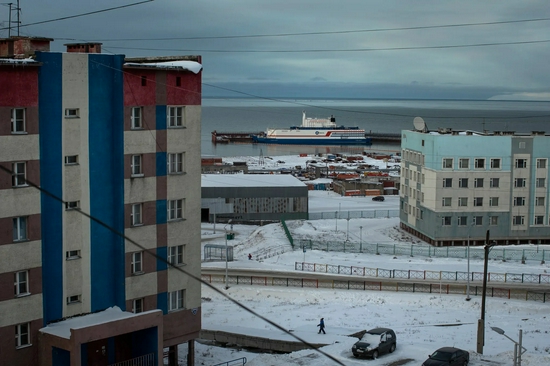核能可以用于民用吗?没错,核能可以用来“烧洗澡水”。俄罗斯正在试验使用“核温水”,这些水从漂浮的反应堆中泵入西伯利亚偏远城镇人们的家中。

A nuclear-powered shower? Russia tests a climate innovation
The water was hot, steamy and plentiful, and Pavel Rozhkov let it flow over his body, enjoying a shower that is not for the squeamish: On his bare skin, he was feeling the heat produced by an atomic reaction, pumped directly from a nuclear reactor into his home.
水很热,水蒸气弥漫,而且水量很大——帕维尔·罗日科夫(Pavel Rozhkov)让水流过自己的身体,享受着一场“硬核”淋浴。在他裸露的皮肤上,他感觉到了原子反应产生的热量,这些热水是直接从核反应堆抽出,泵入他家里的。
“Personally, I’m not worried,” Rozhkov said.
“我个人并不担心,”罗日科夫说
His shower came courtesy of nuclear residential heating, which remains exceedingly rare and was introduced in the remote Siberian town of Pevek only a year ago. The source is not a typical reactor with huge cooling towers but is the first of a new generation of smaller and potentially more versatile nuclear plants — in this case aboard a barge floating nearby in the Arctic Ocean.
他的淋浴是由住宅用的核供暖系统提供的,这种供暖系统非常罕见,一年前才在偏远的西伯利亚小镇佩维克(Pevek)引入。这不是一个典型的拥有巨大冷却塔的反应堆,而是新一代更小、可能有更多功能的核电站——这次是在附近北冰洋的一艘驳船上。
As countries from across the globe meet in Scotland this week to try to find new ways to mitigate climate change, Russia has embraced nuclear residential heating as one potential solution, while also hoping it can bring a competitive advantage. Companies in the United States, China and France are considering building the type of small reactors connected now to Pevek’s waterworks.
本周,全球各国齐聚苏格兰,试图找到缓解气候变化的新方法。俄罗斯已将核住宅供暖作为一种潜在的解决方案,同时也希望它能带来竞争优势。美国、中国和法国的公司也正在考虑建造与佩维克自来水厂相连的小型反应堆。
“It’s very exciting,” Jacopo Buongiorno, a professor of nuclear science and engineering at Massachusetts Institute of Technology, said in a telephone interview. These small reactors, he said, could also warm greenhouses or provide heat for industrial purposes. In bringing to life the new approach, he said, “the Russians are ahead.”
“这非常令人兴奋,”麻省理工学院(Massachusetts Institute of Technology)核科学与工程教授雅格布·布昂乔诺(Jacopo Buongiorno)在接受电话采访时说。他说,这些小型反应堆还可以为温室供暖或为工业目的提供热量。他说,在实施新策略方面,“俄罗斯人走在了前面。”
Nuclear-powered residential heating is distinct from running space or water heaters with electricity generated from nuclear sources. Direct nuclear heating, tried in small pockets of Russia and Sweden, circulates water between a power plant and homes, transferring heat directly from fissioning uranium atoms to residences.
核动力住宅供暖不同于使用核能发电的空间或热水器。在俄罗斯和瑞典的小范围地区尝试的直接核加热,是在发电厂和家庭之间建立循环水系统,将裂变的铀原子的热量直接传送到家庭中去。

Warming homes with nuclear power also has environmental benefits, advocates of the idea say. Primarily, it avoids wasting the heat that is typically vented as steam through the conical cooling towers of nuclear plants, and instead captures it for use in residential heating, if customers are fine with it.
核能的倡导者说,用核能给家庭供暖也对环境有好处。首先,它避免了热能的浪费,这些热能通常以蒸汽的形式通过核电站的锥形冷却塔排出,如果客户不介意的话,可以收集这些热能用于住宅供暖。
Still, some experts are concerned about the potential risks, pointing to the many spills and accidents on Soviet and Russian submarines and icebreakers that used similar small reactors.
尽管如此,一些专家还是对潜在的风险感到担忧。他们指出,使用类似小型反应堆的苏联和俄罗斯潜艇和破冰船上发生了许多核泄漏和事故。
“It is nuclear technology, and the starting point needs to be that it is dangerous,” said Andrei Zolotkov, a researcher with Bellona, a Norwegian environmental group. “That is the only way to think about it.”
“这是核技术,前提条件就是它是危险的,”挪威环保组织Bellona的研究员安德烈·佐洛特科夫(Andrei Zolotkov)说,“我们只能这么想。”
Rozhkov’s wife, Natalia Rozhkova, was initially skeptical. They can see the new nuclear facility, which is about a mile away, from their kitchen window. She said she “worried for the first two days” after their apartment was connected to one of the cooling loops of the reactors. But the feeling passed.
罗日科夫的妻子娜塔莉亚·罗日科娃(Natalia Rozhkova)起初持怀疑态度。他们可以从厨房的窗户看到大约一英里外的新核设施。她说,在他们的公寓连接到反应堆的一个冷却回路后,她“头两天都很担心”。但这种感觉已经过去了。
“Whatever is new is scary,” Rozhkova said. Still, somebody has to be first, she suggested, adding, “We were the closest, so they hooked us up first.”
“任何新的东西都是可怕的,”罗日科娃说。不过,总得有人先来,她建议道,并补充说,“我们是离得最近的,所以就先试用了。”
The experiment in Siberia, Buongiorno said, could play a vital role in convincing countries that using nuclear power to limit climate change will require using it for more than just generating electricity.
布昂乔诺说,在西伯利亚进行的实验,可能有助于说服各国使用核能来应对气候变化,让他们相信,使用核能不仅仅是为了发电。
“Decarbonizing the electrical grid will only get you one-quarter of the way,” he said. “The rest comes from all these other things.”
他说:“电网脱碳只能实现四分之一的目标。其余的则来自所有这些其他的东西。“
Yes, but a nuclear shower? Buongiorno said he would take one — but conceded that “obviously this is not going to work if people don’t feel comfortable with the technology.”
那核热淋浴系统呢?布昂乔诺(Buongiorno)说他会装上一个,但他也承认“如果人们对这项技术感到不舒服,这显然是行不通的。”

Now, two other sites in Russia besides Pevek use nuclear residential heating; however, in those cases, it is a byproduct of large electrical plants.
现在,除了佩维克,俄罗斯还有两个地方使用核住宅供暖。然而,在这些情况下,它都是大型发电厂的副产品。
Soon, in Pevek, the town’s community steam bath, or banya, will also be nuclear-powered. The Russian state nuclear company, Rosatom, connected the reactors to the heating pipes in one neighborhood in June 2020. It is now expanding the hot water service to the whole town, which has a population of about 4,500.
很快,在佩维克,小镇社区的蒸汽浴室也将使用核能。2020年6月,俄罗斯国家核能公司(Rosatom)将一个社区的反应堆与供暖管道连接起来。目前,该公司正在将热水服务扩展到人口约4500人的整个城镇。
The plant’s two cores are cooled by a series of water loops. In each reactor, the first loop is contaminated with radioactive particles. But this water never leaves the plant. Through heat exchangers, it transfers heat — but not contaminated water — to other loops.
核电站的两个核心由一系列的水循环来冷却。在每个反应堆中,第一个回路都受到了放射性粒子的污染。但这些水从未离开过工厂。通过热交换器,它将热量(而不是被污染的水)转移到其他回路。
In Pevek, one of these loops is the system of pipes that leave the plant, branch out and supply hot water to homes.
在佩维克,其中一个循环是管道系统,它离开工厂,分支并向家庭供应热水。
The company promotes a number of safety features. The plant can withstand a crash by a small airplane. The vessel that holds it doubles as a containment structure. And the water circulating through buildings is at a higher pressure than the cooling loop from which it derives heat within the plant, in theory preventing a radiation leak from spreading into town.
该公司推出了一些安全功能,比如这家工厂能承受小飞机的撞击。而且,在建筑物中循环的水柱所处的压力要高于冷却回路的压力,而冷却回路是从核电站中获得热量的,这在理论上可以防止辐射泄漏扩散到城镇。
Irina K. Buriyeva, a librarian, said she appreciated the plentiful heat and electricity. Of the risks of a radiation leak or explosion, she said, “We try not to think about it, honestly.”
图书管理员伊琳娜·布里耶娃(Irina K. Buriyeva)说,她很喜欢这里充足的暖气和电力。对于辐射泄漏或爆炸的风险,她说,“老实说,我们只能尽量不去想它。”
Kirill Toropov, deputy director of the floating nuclear plant in Pevek, said its benefits were already visible locally, citing snow that is less sullied with coal soot. “We need to note this positive ecological moment,” he said.
佩维克漂浮核电站的副主任基里尔·托罗波夫(Kirill Toropov)说,它的好处在当地已经显而易见,他举例说,积雪受到煤烟污染的程度降低了。“我们需要注意这个积极的生态变化,”他说。
Rozhkov, 41, an accountant, who has been showering and bathing three children in nuclear-warmed water for a year now, said Russia’s use of small reactors in icebreakers gave him confidence in the technology.
现年41岁的会计师罗日科夫(Rozhkov)已经用核温水给三个孩子洗澡一年了。他说,俄罗斯在破冰船上使用小型反应堆,让他对这项技术有了信心。
“We aren’t worried,” he said, “that the details are still being worked out.”
“我们并不担心,”他说,“细节仍在优化中。”
His wife said they were “believers,” and added, “There are things we cannot control. I can only pray for our safety, for the safety of our town.”
罗日科夫的妻子说,他们是“拥护者”,并补充说,“有些事情我们无法控制。我只能为我们的安全祈祷,为我们小镇的安全祈祷。”